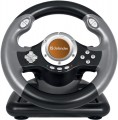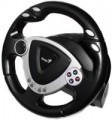Number of buttons
The total number of buttons provided in the design of the manipulator.
The more buttons — the more additional features you can "tie" to the manipulator, the lower the likelihood that during the game you will have to turn to other controls (for example, a PC keyboard). However, many game consoles (see "Platform Compatibility") provide a certain minimum number of buttons for a compatible gamepad — a smaller number simply would not allow full use of all the functions of the console. For example, the original PlayStation 4 controller has 11 buttons.
Note that the D-Pad (see below) is not included in this calculation: it is considered a specific control, although it is based on buttons.
D-pad
The presence of the
D-Pad manipulator in the controller design; the type of such a manipulator can also be specified here.
D-Pad is used to move the character, cursor, etc. in strictly defined, standard directions. In some cases, this can be more convenient than using analogue levers that tilt to either side (see below). As for the varieties, nowadays there are such options:
— 4-position. The classic D-Pad, which appeared at the dawn of game consoles and does not lose popularity nowadays. Available as a set of 4 buttons in a distinctive cross-shaped layout, or as a single solid "multi-sided" button. Anyway, such a device provides 4 fixed directions: up, down, right, left. But to move diagonally, you need to select 2 corresponding directions at once; this is not always convenient, so in this regard, 4-way D-Pads are considered somewhat less practical than the 8-way ones described below. On the other hand, they are also quite functional, while being simpler in design, reliable and inexpensive; and strictly diagonal movements are not required as often as horizontal and vertical ones. So this type of D-Pads can be found even in accessories for the latest generations of game consoles.
—
8-position. A variation of the D-Pad, in which 4 standard directions (2 horizontal, 2 vertical) are supplemented by 4 intermediate — diagonal. In this case, we are usually talking about full-fledge
...d fixed positions of the manipulator; in other words, to move diagonally, you need to click not on two standard directions, but on one intermediate one. The classic design of this type of D-Pad is a multi-sided button, which is the most suitable option in this case. However, this variety also includes some solutions for 4 separate buttons — provided that these buttons are placed very close, and pressing two at once with one finger is not difficult. Anyway, 8-position manipulators are somewhat more expensive, but more convenient than 4-position ones.Steering wheel turn
The angle of rotation of the steering wheel in the manipulator-steering wheel (see "Device type"). This parameter is measured over a general range — from one extreme point to another; accordingly, the angle of rotation from the middle position will be half the total. For example, a figure of 180° means that the steering wheel is capable of turning to the right and left by 90°.
Both the general level and the purpose of the steering wheel directly depend on this parameter. Models with a rotation angle of up to 270° are predominantly entry-level and are intended mainly for fans of arcade racing without much emphasis on realism, as well as for children and novice gamers. In more advanced rudders, the steering angle is already
900 °, or even 1080 °. These numbers are taken for a reason — they correspond to the steering wheel ranges in most production cars (900 °), as well as some sports supercars (1080 °). Thus, such characteristics make the use of the steering wheel as realistic as possible — on the other hand, they significantly affect the cost.
The steering wheel rotation range can be adjusted by the
steering wheel angle adjustment function (if such a feature is implemented in the game controller). The option is configured either directly in the game, or through the software that controls the operation of the steering wheel.
Steering material
The material from which the steering wheel itself is made in manipulators of the corresponding type (see "Device type").
Note that the basis of the steering wheel is traditionally plastic. Therefore, this parameter is indicated by the material of the outer surface of the steering wheel: it is with this surface that the user's hands are in contact, it is she who is primarily responsible for the appearance of the device and the general impression of its use.
— Rubber. Rubber coating is relatively inexpensive, while it is quite convenient and practical. So, due to its softness and elasticity, such a surface is pleasant to the touch, at the same time it looks quite authentic — similar materials are often used in steering wheels of real cars. Therefore, it is this option that is most popular nowadays. Of the disadvantages of rubber, one can note only poor scratch resistance, but this is a common feature of many fairly advanced steering wheel materials.
— Plastic. Steering wheel made entirely of plastic; the outer coating may differ somewhat from the base, however, both belong to the same class of materials. The key advantage of this option is low cost; in addition, plastic can be made sufficiently resistant to scratches, scuffs and other damage. On the other hand, the plastic surface is somewhat less comfortable than the same rubber, and it does not always look solid and reliable enough. In addition, smooth plastic tends to slip in the hands...(although embossed protrusions or other similar solutions may be provided to compensate for this disadvantage). Therefore, this material is used less often, mainly in relatively inexpensive steering wheels (although there may be exceptions using high-quality plastic grades).
— Leather. The cover is made of artificial, occasionally — genuine leather. These materials belong to the premium class: they have a stylish appearance, are pleasant to the touch, but they also cost accordingly. However a leather substitute can be both high-class and relatively inexpensive — however, in the latter case, there is no need to talk about durability and durability; natural leather, in turn, is by definition quite expensive. On the other hand, such coatings provide maximum authenticity — to the point that the controller "smells like a real steering wheel, and not like a plastic toy."
— Alcantara. A material also known as "faux suede". In fact, it is a variety of the leather (imitation leather) described above, however, it stands out in a separate category, as it has specific features — primarily a characteristic velvety surface. Thanks to this, this material is pleasant to the touch, while it looks great and at the same time is quite durable and practical; It is worth saying that Alcantara is widely used in the decoration and external tuning of real cars, including luxury cars. At the same time, the cost of such a finish, including for game steering wheels, turns out to be considerable; therefore, only some high-end models are made from Alcantara.
Power source
The power source used by the gamepad.
This parameter directly depends on the type of connection (see "Connection"). So, power from a
USB port or
network (power supply) is provided mainly in wired models, and devices with wireless connectivity (both purely wireless and combined) are almost guaranteed to use a
battery or
batteries. Here is a more detailed description of each of these options:
— USB port. Powered by a USB port — usually the same one through which the controller directly interacts with the console, PC or other gaming device. This method of connection allows you to do without unnecessary wires. On the other hand, USB power is relatively low, which makes this option poorly suited for controllers with powerful feedback systems (in particular, advanced steering wheels) — you have to use separate PSUs with such accessories (see below).
Also note that this power supply method is also found in separate wireless models — usually controllers for mobile devices that interact with the gadget via Bluetooth, and are powered from the USB port of the same gadget. This format of operation allows you to do without batteries in the controller itself, however, it additionally consumes the charge of the main device.
— Network. Powered from a conventional outlet using a separate power supply unit (PSU). Mainly used
...in high-end wired wheels (see Device Type) that require high power for feedback systems to work effectively. Theoretically, this option is not very convenient, as it requires the search for an additional outlet; however, in fact, this usually does not cause any particular difficulties (in extreme cases, you can use an extension cord).
— Accumulator. Powered by a built-in battery that does not belong to standard sizes (unlike batteries), and often also non-removable. This is the most popular way of powering wireless manipulators nowadays. Its main advantage over batteries is that this option does not require extra money and effort: the battery is initially included in the package, you do not need to buy it separately, and when the charge is exhausted, it is enough to charge the controller. However this procedure requires a certain time; however, the time for a full charge rarely exceeds a couple of hours, while the operating time can be measured for days (although there are also more modest figures). In addition, many controllers can be used without unplugging the charger; this somewhat limits mobility, but this moment is usually not critical.
— Batteries (AA, AAA). Powered by replaceable cells of a standard size — usually "finger" AA or "little" AAA. The number of elements used can be different; however, the general features of such a power supply are the same in all controllers. On the one hand, the batteries allow quick replacement, which allows you to play with a minimum of interruptions: when the charge is exhausted, it is enough to simply install fresh batteries instead of dead ones. At the same time, the user has a choice: either regularly buy disposable batteries, or invest in rechargeable batteries with an external charger. And if you purchase two sets of such batteries, you can keep one set on charge while the second is in use. On the other hand, the use of batteries is inevitably associated with additional costs: batteries are usually not included in the kit, and they must be purchased separately before the first use. As a result, this type of power is used much less frequently than batteries, although it can also be found in fairly advanced and well-known devices — in particular, regular gamepads for Xbox 360, Xbox One and even Xbox Series X|S.
